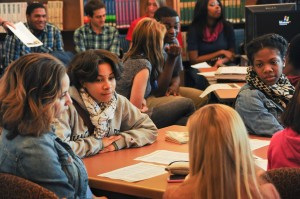Barring students from school is all too common in America. Across the country, schools turn to suspension as the preferred solution to many different kinds of student misconduct ranging from fighting to skipping school. Of course school authorities have to take action when students engage in serious misbehaviors. But an accumulation of evidence suggests that schools would do well to find alternative ways to proceed in many situations. Alternatives to suspension can do a better job of correcting student misbehavior – and may also improve safety for everyone at school and in the broader community. On their own, some school leaders are already taking important steps to reduce reliance on suspensions.
Suspensions Can be Ineffective and Harmful
Research shows that suspension is often a temporary solution that may exacerbate the problem it is intended to address. Suspension often seems like a good way to remove troublemakers from the scene of difficulties, improve security, and focus attention from parents and authorities on student misbehaviors. But there are also clear downsides. Suspension isolates students and increases time spent out of school for students who may already have records of truancy.
Studies have also revealed that suspension is applied inconsistently and hits certain groups more than others. Male students, students of color, and students with disabilities are more likely to be suspended than peers. Moreover, researchersconcur that suspension – especially when repeated or long-term – can lead to many unfortunate outcomes, including higher dropout rates, lower academic achievement, and lives blighted by poverty, low earnings, and interpersonal conflict.Alternatives to Suspension
Given understandable community concerns, state policymakers, school boards, and superintendents feel pressure to “get tough” about student misconduct. But there are various ways to address misbehavior, including alternatives to issuing suspensions that use resources efficiently and maintain a focus on safety and accountability, but without making problems worse for all concerned.
Especially for the sorts of non-violent student infractions that too regularly lead to suspension, schools can turn to various other disciplinary practices to improve student behavior:
-

Photo by U.S. Army RDECOM via Flickr CC. School leaders can require students involved in conflicts to submit to peer mediation, in which a broader set of trained students assigns responsibility and suggests solutions.
- Misbehaving students could in many instances be required to keep attending regular classes, but also spend time in detention before or after school or on weekends.
- School-related community service could be a consequence of misconduct.
- “Suspension” itself can happen inside the school – as one school accomplished by requiring suspended students to do homework at desks located in the school hall nearest the principal’s office.
Reducing Misbehavior to Avoid Harsh Discipline
Additional approaches lessen the problems and misbehaviors that require disciplinary responses in the first place, and these approaches can also serve as mild alternatives to harsh discipline.
- An approach called “Positive Behavioral Intervention and Supports” focuses on using proven methods to provide a steady stream of encouragement and support for positive behavior for all students in the school community.
- Home visits to encourage parental supervision and engagement can head off some problematic student behaviors or situations.
- Schools can head off many infractions by making it clear to everyone what the rules are and what punishments will follow from disciplinary infractions.
- Students and teachers can be accountable for applying and following the rules and carrying through expectations for effective learning. Other stakeholders, including parents, can share responsibility too, encouraging constructive contributions by everyone.
- Instead of just waiting to toss miscreants out of school, educators can create partnerships to facilitate connections for all students to local services and systems providing care and supervision.
What Can Policymakers Do?
School boards and community officials can improve policies in the following key ways:
- At least until students reach the age of compulsory school attendance, eliminate the use of suspension as a response to truancy since it just reinforces absence from school.
- Consider students’ ages when choosing appropriate discipline. Long-term or automatic suspensions are rarely appropriate responses to infractions by very young children.
- Have school authorities take student needs and the contexts of infractions into account when determining disciplinary actions. Sanctions should not be automatic.
- Require schools to use evidence-based prevention programs and have them collect data on different disciplinary approaches to see which work better to improve student behavior and community wellbeing.
Devising good alternatives to suspension will benefit not only students who must be disciplined but also their schools and communities.

 Research to Improve Policy: The Scholars Strategy Network seeks to improve public policy and strengthen democracy by organizing scholars working in America's colleges and universities. SSN's founding director is Theda Skocpol, Victor S. Thomas Professor of Government and Sociology at Harvard University.
Research to Improve Policy: The Scholars Strategy Network seeks to improve public policy and strengthen democracy by organizing scholars working in America's colleges and universities. SSN's founding director is Theda Skocpol, Victor S. Thomas Professor of Government and Sociology at Harvard University.